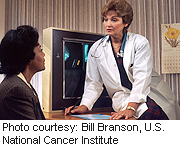
FRIDAY, June 1 (HealthDay News) — With health care becoming increasingly high-tech, fast-paced and cost-conscious, a lot of doctors and patients alike are feeling out of sorts.
Doctors complain about being rushed and overwhelmed. Patients say they’re not being heard or their care is being short-changed.
“What patients complain about the most is, ‘My doctor doesn’t listen to me,’ or ‘I feel like I’m alone in my illness,'” said Dr. Rita Charon, executive director of the Columbia University Medical Center’s narrative medicine program in New York City.
“The problem is doctors are not particularly selected for the profession because we are skilled in making contact with suffering people,” she said. “But that doesn’t mean that doctors are mean or malicious; they’ve just never been given the skills to receive the stories that people tell them.”
Charon hopes to change that. She developed a new tool, called narrative medicine, to help today’s doctors better understand and connect to their patients.
“Narrative medicine is a way for people who take care of sick persons to hear what they say, to understand their concerns, to enter the world of the patients, so as to know what can be done in their care,” Charon said.
An example of narrative medicine in action occurred after a pediatrician attended a weekend training session, Charon said. The doctor, who works in a mostly poor neighborhood with a largely immigrant population, arrived at work the next morning to find five patients waiting for her — a situation that normally would have made her feel stressed right from the start.
But using what she’d just learned about narrative medicine techniques, she opened the first chart to see what that first patient’s story might be.
It was a patient the doctor had never seen before: a small boy whose mother had brought him in because he’d cut his hand on a pair of scissors. The cut wasn’t deep, and the doctor applied some antibiotic cream, covered it with a bandage and explained to the child’s mother how to care for the wound. But thinking there might be more to the mother’s story, she asked if there was anything else the woman wanted to tell her about the scissors.
It turned out that the mother rented a room in her apartment to boarders, and one of them had HIV. The boarders had fought, the man with HIV had been cut with the scissors and the mother was worried that her child might have been exposed to HIV — though she hadn’t expressed that to the doctor. But by simply asking if there was more to the story, the doctor got a fuller picture of what had happened, and that information ultimately changed the course of treatment for the child.
“Narrative medicine helps a practice become more consequential,” Charon said. “What people need before they have true empathy and compassion is to be able to perceive what’s going on with another person. And, when you write it down, you represent it.”
As Dr. Paul Gross, a physician in the family and social medicine department at Montefiore Medical Center in New York City, described it, “narrative medicine captures the stories that go on in a medical encounter that don’t get recorded in a medical chart.”
In fact, Gross is such a proponent of capturing these stories that he’s given doctors an outlet for them, publishing a weekly online magazine called Pulse — Voices from the heart of medicine.
He described a patient he had once who’d been successfully taking antiviral medications to keep HIV from evolving into AIDS. But inexplicably the patient stopped taking the medication. As Gross continued to talk to him, he learned that the man had been a dancer, and he was able to see a clip of him performing in a music video.
“On the surface, he had seemed to me someone who was isolated without a social network,” explained Gross, who said that learning more about the man’s background really changed the way Gross viewed his patient. He learned that the man felt that taking the medications was a burden.
“A patient isn’t just a broken leg or someone who didn’t take their medications,” Gross said. “They’re someone with a story, and if I learn that story, it will make me better able to treat them. And, it may make them more likely to tell their doctor everything that’s going on if they think the doctor is trying to get to know them.”
Training through Columbia’s narrative medicine program involves close reading of different types of literature about illness as well as writing about experiences doctors have had with patients. Participants are taught to better understand and embrace cultural diversity among patients and co-workers; to more clearly communicate opinions, knowledge and responsibilities to patients, families and co-workers; and to collaborate respectfully with other caregivers.
“Most doctors are working hard and are eager to get better at the listening part,” Charon said, adding that training in narrative medicine will increase the number of doctors “with the skills to make sure that they hear what you’re trying to say.”
More information
The American Academy of Family Physicians offers tips on talking with your doctor.

